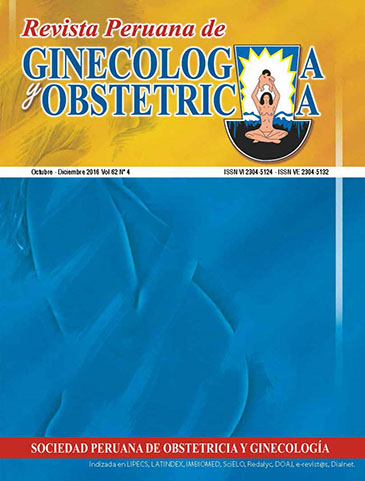Proposal of a risk score for preeclampsia in pregnant women
DOI:
https://doi.org/10.31403/rpgo.v62i1937Abstract
Objectives: To determine a score for risk assessment and screening of pregnant women with and without preeclampsia. Design: Cross-sectional, analytical, case-control study. Institution: Department of Gynecology and Obstetrics, Hospital III Honorio Delgado de Arequipa, Peru. Participants: Pregnant women with and without preeclampsia (PE) who had normal or dystocic vaginal delivery in our Department between June 2015 and June 2016. Main outcome measures: Bivariate analysis of risk factors for preeclampsia. Determination of a cutoff point of risk for preeclampsia. Results: 253 patients were evaluated, 132 patients belonged to the control group and 121 cases to the PE group. The risk factors studied had an odds ratio (OR) greater than 2, being higher for the risk factor mean arterial pressure (OR: 8.80) and smaller for hemoglobin - Hb (OR: 2.749). A cutoff point ≥ 4 appreciated the high risk of PE with a sensitivity of 94.21%, specificity of 87.88% and likelihood ratio of 7.77. Conclusions: The score proposed seems to be useful for the risk assessment and screening of preeclampsia taking a cutoff point of ≥ 4 and can be used in I to III level care centers.Downloads
Downloads
Published
2017-01-06
How to Cite
Apaza Valencia, J., Sotelo Hancco, M., & Tejada Zúñiga, M. (2017). Proposal of a risk score for preeclampsia in pregnant women. The Peruvian Journal of Gynecology and Obstetrics, 62(4), 371–379. https://doi.org/10.31403/rpgo.v62i1937
Issue
Section
Artículos Originales
















